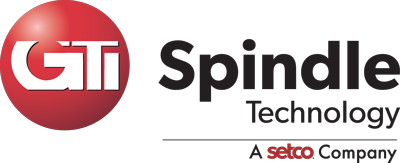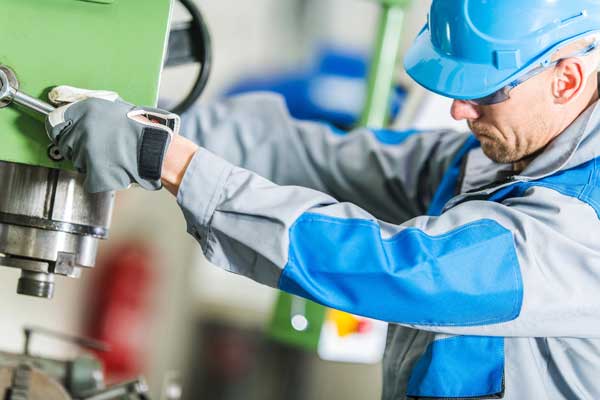Introduction
When asked how they tell if a spindle is failing, many maintenance managers tell us that it is when quality starts rejecting parts, they hear a noise, or the spindle seizes completely.
These tips are meant to help you find and correct spindle problems before catastrophic failure and machine tool crashes. Periodic predictive maintenance and inspection will also help you reduce scrap, decrease downtime and save money on spindle repairs.
Training, Documentation, Commitment
“Train everyone lavishly, you can’t overspend on training.”
-Thomas Peters
“Being well trained means you can train others”
-Brette Powell
So, how do we move this training mountain? Here are some things to consider:
- Start with a plan. What skills are absolutely critical to you reliability maintenance goals?
- Decide who best to train in different disciplines. Not everyone needs to attend every training session. Train the team members that will benefit most.
- When you find someone that excels at a skill, teach them to be a trainer to save on external training costs.
- Ask external trainers if they will leave behind training materials for future internal use.
- Look for online training tools.
- Put training on your maintenance schedule. Use local and internal resources to provide training.
- Involve your entire reliability maintenance team – ask them where the skills gaps are in your organization.
Vibration Analysis in Spindles
If measured on a regular basis, vibration data will give early warning of impending bearing failure. Starting with a baseline measurement and trending over time is the first line of defense to detect problems.
Industry standard alerts and alarms are a simple way of tracking vibration issues. When alerts and alarms occur, more data can be collected on the spindle for more accurate analysis.
Here are some basic tactics for collecting vibration data on spindles:
- Always measure at the same speed and the same load. Make sure there is time for the operator to set up the optimal conditions for measurement.
- Monthly data collection during a maintenance shut down or shift change will give good trends.
- Keep machine measurement routes short and easy to finish – you don’t have to measure the entire plant in a day.
- For most spindles, a single measurement point per spindle will give you a good trend.
- Data can be collected from vibration sensors permanently mounted. This keeps the operator from having to completely shut down the machine to provide access. It is a safer and more convenient means of collecting data.
Add temperature data to your vibration trends for better failure prediction. Temperature increases are an indication of increased friction in the bearing and lubrication issues – both over and under lubrication. Combined with vibration data your monitoring program will give ample early warnings.
Ask you spindle repair provider to include a vibration certification report when a repaired spindle is returned. If your installed vibration readings are significantly different from the shop report, then there could be other components in the system that are contributing to the vibration problems.
- Installation of new bearings
- Grind-chrome plate-regrind of shaft bearing journals
- Grind-chrome plate-regrind of the housing bores and/or stator rewinds.
At GTI Spindle Technology, we refer to this a “schedule C” repair. $$$$
By removing the spindle when the vibration levels are in the upper end of the velocity thresholds of 0.1-0.2 in/sec and upper end of acceleration thresholds of 2.5-4 g’s you reduce the extent of damage that is caused as the bearings deteriorate. This would typically result in a repair including but not limited to:
- Installation of new bearings
- Limited grind-chrome plate-regrind.
This would be classified as a “schedule B” repair. $$$
By removing the spindle when the vibration levels are in the lower end of the velocity thresholds of 0.1-0.2 in/sec and lower end of acceleration thresholds of 2.5-4 g’s you significantly reduce the extent of damage that is caused as the bearings begin to deteriorate. This would typically result in a repair including but not limited to:
- Installation of new bearings
- Very little if any grind-chrome plate-regrind needed.
This would be classified as a “schedule A” repair. $$
Bearing Failure – Part 1
- Poor storage and handling
- Contamination
- Overload
- Incorrect preload
- Imbalance
- Drawbar mechanism failure
- And, sometimes bearings just fail
Let’s start by looking look at the basic things you need to keep in mind for proper bearing storage and installation.
 How the bearings are stored and handled is a huge consideration. Rolling element bearings should be stored in a cool, low humidity environment that is free from shock, vibration and dust. Poor storage conditions can cause defects to the bearing races before the bearing is ever used.
How the bearings are stored and handled is a huge consideration. Rolling element bearings should be stored in a cool, low humidity environment that is free from shock, vibration and dust. Poor storage conditions can cause defects to the bearing races before the bearing is ever used.
Simply, the most effective bearing maintenance is to keep it clean. Spare spindles in storage should be rotated periodically to prevent the bearings resting in the same position. Over time not rotating the spindle can cause flat spots on the bearing that can lead to early bearing failure.
Prior to mounting a new bearing, check the bearing housing and shaft to make sure they are clean and not damaged. Also, check the shaft and housing for out of round and taper. Use the tables supplied by the bearing manufacturer to ensure that the correct amount of clearance will be present when the bearing is installed.
Make sure you are replacing the old bearing with one that is identical. The lubricant must be clean and of the correct specification. Have the correct tools and equipment on hand and keep the work area clean.
Don’t remove the bearing from its wrapping until its time to install and do not wash the bearing. Make sure you know what method will be required to mount the bearing.
Mechanical mounting methods are acceptable for small bearings. Always use the correct mounting tools (as opposed to a sledge hammer) and apply “minimum force with maximum control”. Never strike the bearing directly!
Improper mechanical installation can damage the bearing and start it on the path to premature failure. For larger bearings, heating and induction methods can be used. This method will allow the bearing to fit over the shaft and into the housing more easily.
Once again, the key is training and commitment. Your bearing supplier should have a quality training program. While you can purchase bearings from a number of sources for a variety of prices, availability of training should be a paramount in your bearing supplier selection process.
Bearing Failure – Part 2: Contamination
- Airborne contaminants from compressed air systems (air-oil lubricated system)
- Ingress through worn bearing seals
- Using the wrong lubricant
- Poorly stored (contaminated) lubricant
- Internal component failure (metal)
- Poor installation
In an air-oil lubrication system it is critical to bearing life that clean dry compressed air is used. Air from the compressor should be dry and filtered, and filters checked and changed regularly.
An annual compressed air system audit will also prevent contamination, not to mention save additional energy dollars by improving the system efficiency. Additional coalesor filters can be added on the airline ahead of the oiler with 0.5 micron filters for better efficiency.
Seals need to be properly installed to manufacturer specifications to reduce ingress of chips and debris from the machining process. Preventing these chips and debris from building up to the point of contact on seals will also help extend the life of the seal.
All spindle, bearing and seal assembly should be carried out in a clean room to prevent contamination.
When dealing with lubrication, it is always good to go to an expert. Here is a good tutorial from Jarrod Potteiger of Des-Case about proper lubrication handling and storage to prevent contamination. Click here to view the tutorial.
Here is what you will learn:
- New oil is not clean. It must be filtered before use.
- World class storage and handling methods are not necessarily expensive.
- Good contamination control practices require good storage and handling.
Bearing Failure – Part 3: Overload and Preload
 Preload is set when the bearing is installed in the spindle. Setting the preload properly is a must for good spindle performance and long bearing life.
Preload is set when the bearing is installed in the spindle. Setting the preload properly is a must for good spindle performance and long bearing life.
Insufficient preload will cause the balls in the bearing to skid or skip, resulting in premature failure and poor tool performance and can lead to poor product quality.
Excessive preload can load can cause heat and friction, leading to premature bearing failure. Bearing preload influence and is influenced by speed limits, rigidity and workloads.
Here are some good rules to remember:
- Doubling the load reduces bearing life by one tenth
- Doubling speed reduces bearing life by one half
Always pay close attention to the operating specifications provided by the machine tool and spindle manufacturer.
Bearing Failure – Part 4: Imbalance
This can lead to premature bearing failure and high spindle repair costs if not addressed in its early stages. More importantly, imbalance in a spindle will diminish product quality and product will be outside its expected tolerances. The first sign of a problem may come from the QA department, resulting in unplanned downtime and scrapped production runs.
Imbalance in a spindle can be caused by many influences:
- Poor drawbar retention, resulting in tool looseness
- Continual pressure from cutting patterns on the same points within the tool holder
- Poor bearing install
- Tool holder and tool imbalance
Imbalance in the vibration spectrum is characterized in the vibration spectrum by a dominant one times peak and, with a little training, is easily recognized. There are industry standard vibration levels to help identify imbalance problems. Imbalance can be corrected in the field with balancing tools and proper training.
Special measuring tools and training are required to detect and correct imbalance. A best practice for helping prevent imbalance is to require all spindles coming into your facility, whether new or rebuilt, to have a certificate of balance included.
Set a standard and make your suppliers live up to it with documentation. Cutting tools and grinding wheels should also be balanced before being installed on a spindle.
Make sure all of your millwrights, mechanics and technicians are trained to recognize and correct imbalance in the equipment they are responsible for.
Bearing Failure – Part 5: Drawbar Mechanisms
Check the drawbar force at least every two months using a commercially available mechanical gauge. A good time to check drawbar force is whenever you collect your vibration data. You can record and trend drawbar force as a companion to you vibration and temperature levels.
Specified drawbar force will differ with different machines and spindles:
- 40 taper spindles specify 1,800 to 2,500 pounds of force
- 50 taper spindles specify 3,800 to 5,000 pounds of force, sometimes as high as 9,000
- Be sure you know you manufacturer specifications
- Make sure you are using the correct set up for your application
A drawbar repair can cost hundreds of dollars if caught early. Drawbar failure can cost thousands when you consider the effects of a spindle crash, spindle grinding and lost productivity due to downtime.
Visual Inspection
-Webster’s DictionaryStop, look and listen! Sometimes low tech is your best defense against early failure. This is a good way to get machine operators involved with maintenance. Train them to look for the signs that their machines are having a bad day. In fact, train everyone that walks the plant floor to look and listen for the warning signs.
Schedule regular visual inspections and use a clear checklist that everyone can understand to document any problems. Make sure everyone understands any gauges associated with the machine (oil level, temperature, pressure, etc.) and that they know the acceptable operating levels.
 Learn what a good running machine sounds like. Then listen for grinding, squeaking and other irregular sounds – all indications of worn or damaged bearings. These noises will be loud compared to a good machine.
Learn what a good running machine sounds like. Then listen for grinding, squeaking and other irregular sounds – all indications of worn or damaged bearings. These noises will be loud compared to a good machine.
Look for problems like oil or grease leaks around seals. Ensure that any debris build-up on the seals is removed. Check for cracked bearing housings and machine feet. Look for missing bolts and check for loose bolts. Check belts for cracks, wear and tension.
Check the lubricant levels for under or over lubrication. Discolored or dark lubricant is a sign that the lubricant is contaminated or worn out. Worn out or contaminated oil may be caused by overheating. If it is cloudy, there may be water contamination. Always make sure the air vent is not obstructed.
If applicable, have a schedule to inspect air filters and ensure that the correct filter is being used.
A good visual inspection program, where every one knows what to look for, should involve all the senses. Feel for excess vibration and hot bearing housings. Listen for sounds that are out of the ordinary. Smell for electrical, friction or burning.
iPad Applications and What They Mean to Reliability Maintenance
Once a company owns an app, they own it forever. That means that app software is free to the user after the purchase of the first unit. Upgrades are free through the App Store – and they come automatically, with alerts on the iPad when they are available.
Second, all of the different technologies can be developed as apps – vibration, infrared, balancing, ultrasound, motor testing, laser alignment – all can be apps on a single platform. Need a new technology? Contact the vendor for any hardware and download the app. The iPad is a one-time purchase.
Thirdly, iPads are not purpose built. It can function as whatever tool you want it to be that day. Because all of the functionality is developed in software it is simple to upgrade (most upgrades are free through the App Store) and it is simple to add new functions and capabilities as customers ask for them. There is no need for a list of upgrades that will be included in the next version of hardware that you have to purchase to upgrade.
You dropped the iPad? No problem, you run to the local computer store and get a new on; sync all your apps and reload your data from the cloud. It is less expensive and, certainly, takes less time than sending your display unit back for repair and waiting 2-3 weeks to get it back.
What else can we do with an iPad?
- Preventative maintenance check lists
- Photo documentation
- Video documentation
- Inspection checklists
- Integrated reports with multiple technologies on the same report
- Training videos
- Complete user manuals
- Maintenance procedures
- Work orders with parts lists and specifications
- Whatever you can think of
One iPad, multiple technologies, add new technologies when you want/need to.
Summary
“Learning is not compulsory…neither is survival.”
-W. Edwards Deming
By now you are probably thinking this is all just common sense, but sensible or not, it is not that common. All programs start out with great goals, but without commitment at all levels, great training and good documentation these goals can get lost.
Never be afraid to question the status quo (“Because it has always been that way”) or to ask why. Always look for training opportunities – on-site, classroom or on-line. If you make a strong commitment to the maintenance process – and own it – then others will follow.


